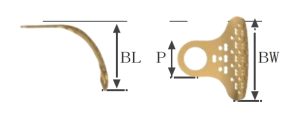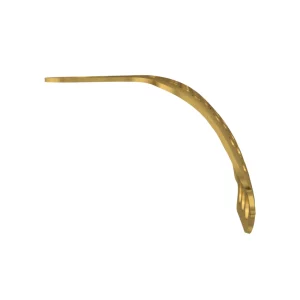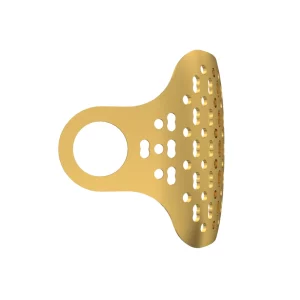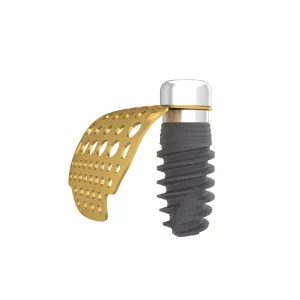Product Name: T-shaped Titanium Mesh For Dental Implants
Material: Made of FDA-approved titanium
Part No. 7024408720
Specification:
Proximal width (P) 4 mm
Labial width (BW) 8 mm
Labial height (BL): 7 mm
Titanium, with its high stiffness, low density, corrosion resistance, and good biocompatibility, is widely used in surgical procedures. As an application of titanium, the T-shaped titanium mesh possesses unique characteristics for bone augmentation (GBR). Its perforated design provides excellent blood supply channels, promoting healing; the ultra-thin design significantly reduces the sensation of a foreign body while enhancing support strength; the anatomical curvature design ensures a high degree of conformity during surgery; and the included bone screws further enhance fixation stability, ensuring the titanium mesh remains secure. Additionally, the T-shaped Titanium Mesh For Dental Implants can be cut and shaped, making it easy to operate and meeting the personalized needs of different patients, making it an ideal choice for dental bone grafting.
Proximal width (P) 4 mm
Labial width (BW) 8 mm
Labial height (BL): 7 mm

Titanium mesh exhibits outstanding mechanical properties, with its exceptionally high strength and stiffness providing a solid spatial support framework for new bone tissue. This ensures that the bone graft maintains a stable volume during the complex healing process, which is key to achieving ideal bone regeneration results. Additionally, the stability of the titanium mesh effectively resists external stresses, preventing implant displacement and ensuring the longevity of surgical outcomes.
The elastic qualities of titanium mesh significantly reduce the sensation of pressure on surrounding oral mucosa, enhancing patient comfort and creating favorable conditions for the health of oral soft tissues. This material is not only resilient but also remarkably flexible. Its excellent malleability allows surgeons to perform precise bending and shaping operations, enabling accurate adaptation to various complex bone defect shapes and facilitating personalized treatment.
These characteristics make GBR with titanium mesh capable of demonstrating highly stable osteogenic effects, achieving simultaneous bone augmentation in both horizontal and vertical directions.
The thickness and pore design of the titanium mesh are critical factors in precisely regulating the total amount of new bone formation and the ratio of bone to soft tissue regeneration. The thickness of the titanium mesh directly affects its mechanical properties; as thickness increases, both mechanical strength and stiffness also enhance. After careful consideration, the choice of a precise thickness of 0.2 mm allows the mesh to exhibit excellent rigidity, ensuring it provides stable spatial support for the bone regeneration process while effectively protecting the graft.
This design offers just the right amount of flexibility to minimize pressure on surrounding tissues, significantly reducing the risk of tissue damage or rupture. It cleverly balances the demands of mechanical stability and biocompatibility, creating an ideal microenvironment for new bone growth. Additionally, it plays an active role in promoting the balanced regeneration of bone and soft tissue, providing a more refined and efficient treatment option for periodontal reconstruction and bone defect repair.

Titanium mesh exhibits outstanding biocompatibility, allowing it to harmoniously coexist with surrounding tissues and reduce rejection reactions. This creates an ideal platform for bone regeneration and soft tissue repair. While titanium has relatively low electrical conductivity, this characteristic contributes to its corrosion resistance. The surface of titanium easily forms a dense oxide layer, which possesses passivating and inert qualities, effectively preventing external corrosive agents from damaging the titanium mesh and surrounding bone tissue. Moreover, titanium and its oxides are proven to be non-toxic to cells, ensuring they do not interfere with the normal growth and repair processes of bone tissue.
The anatomical curvature design is based on in-depth studies of the intricate structures of human bones, ensuring that the titanium mesh conforms closely to areas of bone deficiency during surgery, allowing for precise implantation and stable support. This degree of fit not only enhances the success rate of the surgery but also promotes post-operative recovery, enabling bone tissue to grow quickly along predetermined paths.

To further enhance the stability of the titanium mesh, it is equipped with a bone screw system. These screws can securely anchor within the bone tissue, providing additional support for the titanium mesh and effectively preventing displacement or detachment during the healing process. This dual fixation design creates a stable and predictable environment for bone regeneration.
The titanium mesh is also cuttable and moldable, allowing surgeons to make personalized adjustments based on the specific conditions of each patient. Whether dealing with complex bone defect shapes or particular surgical needs, the titanium mesh can be perfectly adapted through precise trimming and shaping, simplifying the surgical process and improving operational efficiency.

Step 1:
Incise the periodontal flap and place the implant into the surgical area.
Step 2:
Use a measuring instrument to assess the bone defect:
1. Measure the width of the edentulous space.
2. Measure the buccal defect width.
3. Measure the height of the buccal defect on the alveolar ridge.
Step 3:
Select the appropriate size of titanium mesh.
Step 4:
Install the suitable connection base and screws, securing the base with a screwdriver.
Step 5:
Fill in bone graft material, aligning the holes in the titanium mesh with the screw holes of the connection base.
Step 6:
Choose either a healing abutment or cover screw to secure the titanium mesh, based on whether it’s a first-stage or second-stage surgery.
Step 7:
Cut a collagen membrane to the appropriate size and cover the surgical area to guide bone regeneration. Suture the incision; the healing period is typically 3-6 months, depending on the extent of the bone defect.
Step 8:
Incise the flap, remove the healing abutment/cover screw, and connect the ion base to the titanium mesh. Use a screwdriver to place the healing abutment to form a cuff and suture the incision.
DentalMaster é uma empresa especializada em dentisteria de implantes. Marcas como Nobel Biocare, Short Bicon, Straumann, Zimmer, Megagen, Dentium e Hiossen são marcas registadas das respectivas empresas. A DentalMaster não tem nenhuma afiliação comercial com essas empresas. A menção dessas marcas tem como único objetivo identificar com precisão os implantes, instrumentos, pilares e componentes compatíveis oferecidos pela DentalMaster.
Direitos de autor © 2024 Dental Master CE / ISO13485. Todos os direitos reservados.